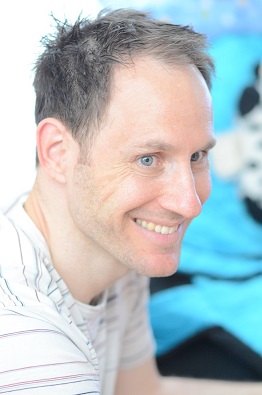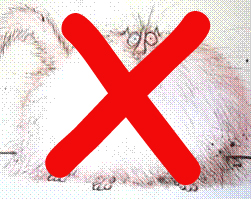I am taking a deep breath (diaphragmatic breath… as I am not doing Pilates right now, only writing about it…) and thinking- where should I start my reply to Brett’s lovely article. I must start with the cat story because despite the smile it brought to my face I have to put things straight… there is no way on earth that a cat will walk into our home without my partner going mad… you see- he absolutely loves dogs and he just can not understand why people love cats.
As for breathing- the subject of our current discussion- I have to agree that “breathing is fully dependent on the efficient and balanced use of the whole being”. In fact, one of the main points of my breathing workshop is to demonstrate the relationship between posture, movement and breathing and to show that we can pay attention and improve the efficiency and capacity of our breath in the same way that we do with the rest of the body. You see, it is because they go hand in hand that it is so vital to pay attention to your breath and/or lack of.
I spent a good number of years training to be a dancer. We paid attention to technique, to moving from a strong centre while not holding tension in the neck, shoulders or extremities and to moving and looking graceful. The whole body was addressed and yet I ended up with some very annoying breathing issues… my point being- trying to pay attention to the whole is not necessarily going to “automatically” address imbalanced and lacking breath.
Mr Pilates said in his book RTL “Lazy breathing converts the lungs, figuratively speaking, into a cemetery for the deposition of disease, dying and dead germs as well as supplying an ideal haven for the multiplication of other harmful germs. Therefore, above all, learn how to breathe correctly.”
I am not sure re the term lazy… but my experience shows me that people have restricted breath pattern for many different reasons- postural deviation such as kyphosis and scoliosis; habitual patterns such as sinking into one side or twisting into one side; work station habits; pain and old injuries that leave a “mark” in the body and also stress and strong emotions that have a way of expressing themselves in our viscera and diaphragm.
I am fully aware that focusing too much on the breath can sometimes become counter productive. I would agree that sometimes it is best to move on and not insist on breathing one way or another. But I would also claim that I can see how breathing techniques help people get better and healthier every day. Here are a few thoughts about breathing techniques:
ü They can teach people the coordination of breath and movement required in this method (although not by all teachers). For example, many people find it easy to engage into a movement on a breath out but struggle to do it on a breath in (or the other way around). Breathing techniques can help them feel comfortable with both- improving their coordination, adaptability and awareness.
ü Breathing can help people find their core or power house engagement. I particularly like Deep Abdominal Breathing as a way of finding the release and engagement of core muscles.
ü Directed breathing can help people find a sense of opposition in the body. I love Amy Alpers’ cue in the Double Leg Stretch “fill your lungs with air as if to counterbalance the weight of the outstretched legs” (apologies if I didn’t get it correctly word to word)
ü Breast Bone Breathing and One Lung Breathing are great tools to help facilitate movement where there is tension and stiffness. Percussive Breathing may help as well at times.
ü Breathing techniques can help draw attention to an imbalanced breath pattern (such as breathing more into one side than the other), offer a way to address it and bring about more balance by correcting it.
My personal journey taught me that breath can sometimes be the missing link- the one element that if shaped differently, will take the movement expression and experience into a completely different level. I witnessed and felt in my own body how deep breath can open the thoracic spine (physically, not just as an image), re-organize the shoulder girdle and bring freedom of movement to the arms. I have worked with numerous pregnant ladies who found breathing exercises helpful throughout their pregnancy and child birth and with post natal woman who used it to find their core again and wake up their muscles. My Scoliotic clients LOVE breathing “into one lung” while stretching to one side and my Kyphotic clients love breathing into their breast bone while stretching over a small ball.
All in all I would say that breathing techniques, when used timely and correctly can bring a lot of good and make our movement experience more wholesome and joyful.
Keep breathing…
Amit
 Amit started his Pilates journey through the Romana lineage- taking Mat classes as a dance student in Rotterdam, Holland. He then trained to be a teacher following the Carola lineage and later completed training and became a teacher trainer for BASI Pilates. Amit has presented classes and workshops in Pilates studios and conferences in the United States, Japan, Israel, and across Europe. His main interest and expertise is in working with Pilates teachers to improve their teaching skills and sharpen their methodology and techniques in order to enable them to become better teachers.
Amit started his Pilates journey through the Romana lineage- taking Mat classes as a dance student in Rotterdam, Holland. He then trained to be a teacher following the Carola lineage and later completed training and became a teacher trainer for BASI Pilates. Amit has presented classes and workshops in Pilates studios and conferences in the United States, Japan, Israel, and across Europe. His main interest and expertise is in working with Pilates teachers to improve their teaching skills and sharpen their methodology and techniques in order to enable them to become better teachers.
Amit comes from the world of Performing Arts. His ten years dance career has taken him all over the globe, performing with various companies. His extensive dance training includes not only Ballet and Modern techniques, but also Pilates, Feldenkrais and other Mind-Body methods. In addition to being a dancer, Amit has performed as a Violinist and has taken part in professional Theatre and Opera productions.

